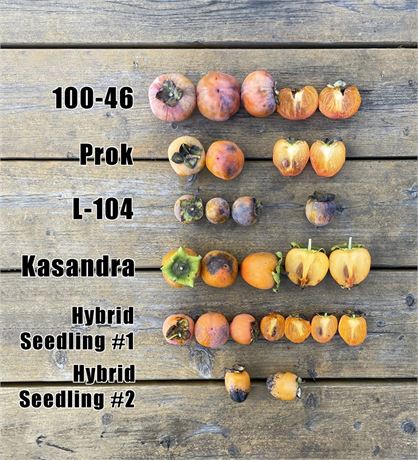Does anyone wonder why every persimmon kaki or American has so little information available about them? I’m making it my goal to change that. I realize it is self explanatory all American persimmons are astringent until ripe and all kaki are non astringent. Hybrids are astringent typically. There is much to know which explains why persimmons are even less valued than pears. Does everyone realize an astringent 50/50 hybrid like JT-02 aka Mikkusu are one of the few i believe are hardy enough to survive in the country in Kansas? FigBid - Online Auctions of Fig Trees, Fig Cuttings & Growing Supplies - JT-02 (A Hybrid Persimmon)


City growers can grow less than 10-15 types. That said it is an easy conversation about hybrids with people from Kansas. That wont likely be true in a few more years. That puts us here in this thread with Improved American persimmons. American persimmons are delicious in my experience. They are soft and not firm. There is simply 60 and 90 chromosome types. Simple ends there and questions arise. Which is the smaller tree , has the largest fruit, ripens earliest , and where do they grow naturally? Those answers have peaked everyones interest but the answers are not concrete but the generalizations are possible though not precise in ploidy discussions Persimmon ploidy impact on height . What is true is that Tetraploid aka 60 chromosome persimmons and Hexaploid aka 90 chromosome Persimmons dont always know where they are supposed to grow. One of our forum members @Lucky_P is mentioned here in this document which i want to point out. Notice all of these much larger types in this document are 90 chromosome types. The 60 chromosome type persimmons tend to be smaller fruited.

PomperASHS2017_a.pdf (447.1 KB)
@Lucky_P notes sfes is actually 60 chromosome. He has grown these improved types over 20 years. Notice he says its smaller fruited which confirms what i said above. Quoting Lucky he says “look at the chart in Kirk Pomper’s article on ploidy levels… SFES, which is my own local selection - is a tetraploid 60C selection - the ortet is an open grown tree, in a fenceline bordering a crop field, alongside KY Hwy 91… it has a spreading orchard-type habit and is less than 20 ft tall; I have no idea how old the tree is, but certainly no less than 30-40 yrs, as it was a mature, fruiting tree when I first noticed it…not significantly taller today than it was 20 years ago.When I first selected SFES, I thought it might be a polygamodioecious male… but no, it’s a female, as far as we can tell. Produces about 80% small seedless fruits, and 20% larger fruits, usually with a single seed… but even those larger fruits are small in comparison to Yates, Prok, etc.” We look at Yates and Prok and clearly see the larger types Lucky compared this tree with are 90 chromosome.